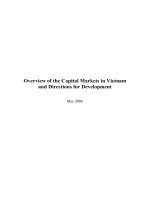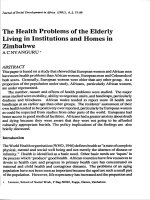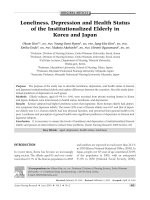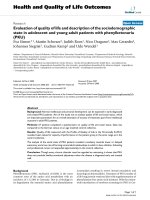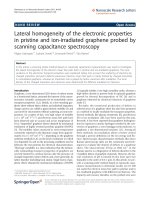Antioxidant activity of the flavonoid hesperidin in chemical and biological systems
Bạn đang xem bản rút gọn của tài liệu. Xem và tải ngay bản đầy đủ của tài liệu tại đây (1.03 MB, 15 trang )
Antioxidant Activity of the Flavonoid Hesperidin in Chemical and Biological
Systems
Scientific seminar - Lam Thu Huyen
K63D2 - Phamarceutical Chemistry - Ha Noi university of Science
I.Background: General about hesperidin
Hesperidin
Wilmsen P.; J. Agric. Food Chem. 2005, 53, 4757−4761
I.Background: properties of hesperidin
antiallergenic
anticarcinogenic
vasodilator properties
antihypotensive
antimicrobial
Wilmsen P.; J. Agric. Food Chem. 2005, 53, 4757−4761
I.Background: hesperidin's ability to scavenge free radicals and reactive oxygen species
1. General about free radicals
cancer cell
Wilmsen P.; J. Agric. Food Chem. 2005, 53, 4757−4761
I.Background: hesperidin's ability to scavenge free radicals and reactive oxygen
species
2. Experiment
and result:
orange juice
mandarin juice
→ reduce in colon and lung cancer
→ study the antioxidant activity of
hesperidin
Wilmsen P.; J. Agric. Food Chem. 2005, 53, 4757−4761
I.Background: method used to evaluate antioxidant capacity of hesperidin
Method: in vitro
Wilmsen P.; J. Agric. Food Chem. 2005, 53, 4757−4761
II.Problem
In vivo
Wilmsen P.; J. Agric. Food Chem. 2005, 53, 4757−4761
III.Methods & results: modified Yamaguchi et al. method
•
using a modified Yamaguchi et al. method → compare hesperidin with trolox - an antioxidant.
250 µM of DPPH (radical)
hesperidin & trolox
dissolved in ethanol + Tris-HCl
(diluted in DMSO)
buffer ( difference
concentration)
Wilmsen P.; J. Agric. Food Chem. 2005, 53, 4757−4761
maintained in dark 20min befor
using spectrophometry method
at 517 nm
III.Methods & results: modified
Yamaguchi et al. method
•
result:
reduced the level of the DPPH٠ in a similar way to the
antioxidant trolox ( positive control) except 10 µM
higher capacity of reducing the DPPH radical than trolox
Figure 2. DPPH٠ concentration reduced by hesperidin (■) and
trolox ().
Wilmsen P.; J. Agric. Food Chem. 2005, 53, 4757−4761
III. Methods & results: using yeast cells
1.
.
Target
3. Yeast use in method
Evaluation of antioxidant capacity using yeast cells
2. Advantages of method
.
testing of various products
.
fast
.
sensitive
.
reproducible
.
reliable results
Saccharomyces cereVisiae
•
possesses a variety of antioxidant defenses
•
in experiment: using superoxide-dismutase
( SOD) proficient and deficient strains
Wilmsen P.; J. Agric. Food Chem. 2005, 53, 4757−4761
III. Methods & results: using yeast cells
3. Procedure
2 × 106 cells/mL
exponential-phase
hesperidin in DMSO
S.cereVisiae
( 25 and 50 µM)
cells
Wilmsen P.; J. Agric. Food Chem. 2005, 53, 4757−4761
stressing agents 1mM
(paraquat herbicide
& hydrogen peroxide)
III. Methods & results: using yeast cells
incubated in YPD medium
6h, 28°C, 130 rpm
diluted in 0.9% (w/v) NaCl, plated onto YPD agar
incubated 72h, 28°C
compare with
control plates
(beginning)
Wilmsen P.; J. Agric. Food Chem. 2005, 53, 4757−4761
III. Methods & results: using yeast cells
4. Result
•
protect cells
from damage
induced by
stressing agents
Table 2. Survival of SOD Proficient and Deficient S. cerevisiae Strains Treated and Untreated with the Antioxidant Hesperidin and/or the
Stressing Agents Paraquat or Hydrogen Peroxide
Wilmsen P.; J. Agric. Food Chem. 2005, 53, 4757−4761
IV. Conclusions & discussions
•
•
the significant antioxidant activity of hesperidin both in vitro and in vivo assay
hesperidin can be considered as a potentially active compound for use in conditions where reactive oxygen species are implicated
Wilmsen P.; J. Agric. Food Chem. 2005, 53, 4757−4761


